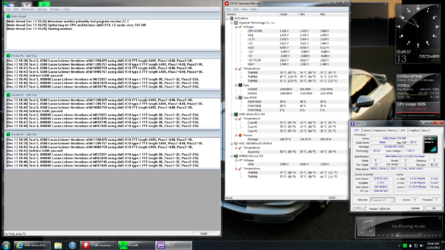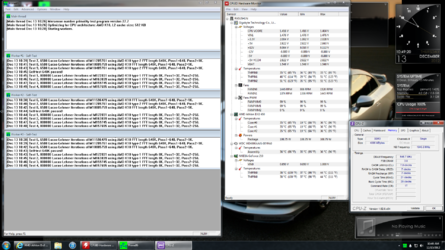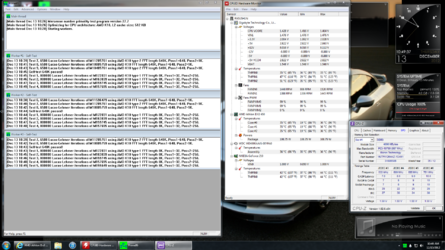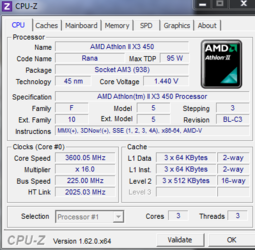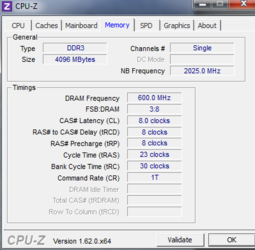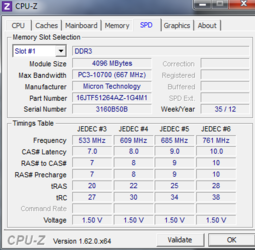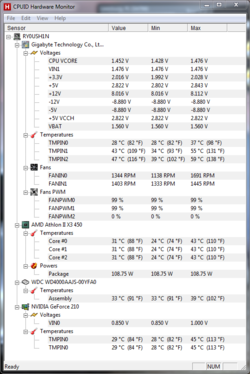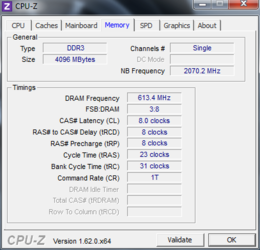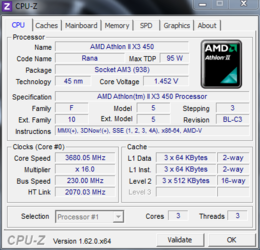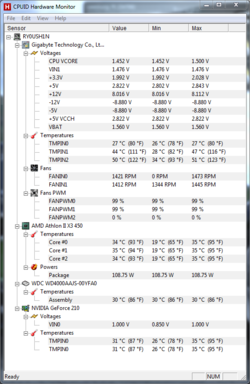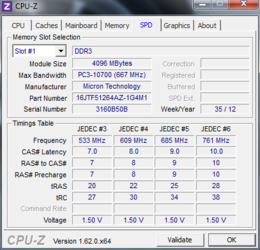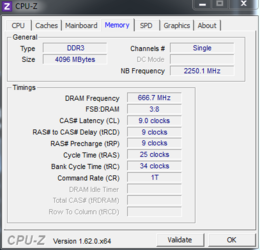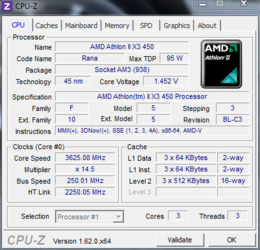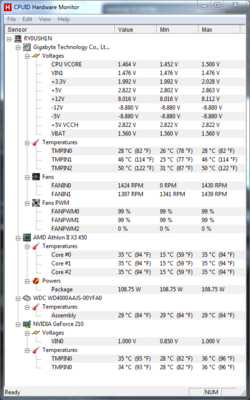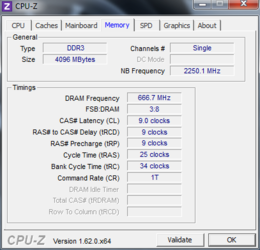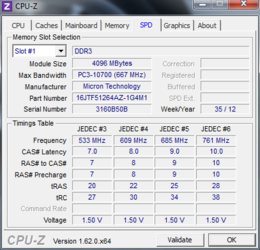-
Welcome to Overclockers Forums! Join us to reply in threads, receive reduced ads, and to customize your site experience!
You are using an out of date browser. It may not display this or other websites correctly.
You should upgrade or use an alternative browser.
You should upgrade or use an alternative browser.
AMD Athlon II x3 450 Rana... Need help to OC
- Thread starter Ry0uSh1n
- Start date
- Thread Starter
- #42
Initial Start.
Bios Values:
CPU Clock Ratio - x16
CPU Northbridge Freq - x9
CPU Host Control - 205
HT Link Freq - x9
Memory Clock - x5.33
DDR3 Volt - Normal or stock setting
CPU Volt - 1.47 (from 1.45 stock)
CPU NB VID - 1.20
Load Line - Regular
Here's a question, to determine my max clock, am I looking for my temps to get near or close to 65 in TMPINx and 70 in CORE, without going BSOD? Also, of the NB Freq and HT Link freq, on my previous board those were set to x10, but there again different board different cpu, reactions are different. In either case heres my start with the stats listed above.
EDIT: The screens are of my cpu, memory, and spd tabs of CPUZ
Bios Values:
CPU Clock Ratio - x16
CPU Northbridge Freq - x9
CPU Host Control - 205
HT Link Freq - x9
Memory Clock - x5.33
DDR3 Volt - Normal or stock setting
CPU Volt - 1.47 (from 1.45 stock)
CPU NB VID - 1.20
Load Line - Regular
Here's a question, to determine my max clock, am I looking for my temps to get near or close to 65 in TMPINx and 70 in CORE, without going BSOD? Also, of the NB Freq and HT Link freq, on my previous board those were set to x10, but there again different board different cpu, reactions are different. In either case heres my start with the stats listed above.
EDIT: The screens are of my cpu, memory, and spd tabs of CPUZ
Attachments
- Joined
- Dec 27, 2008
Can't make out the values in the images of your last post. I'm using a very small screen right now. Please don't cram so much into one image. It shrinks things down too much. It would be better to crop each image (Snipping Tool in Windows Accessories is great for this) and attach it separately.
The answer to your question about increasing frequencies and voltages until you hit a temp wall is "yes". You seem to have grasped the idea correctly.
Concerning your question about having used a 10x HT Link and NB multiplier on a previous system, it may have been a system with a black edition CPU that allowed a much simpler method of overclocking - simply increasing the CPU core frequency raitio, what we commonly call the CPU multiplier. On the Rana core CPUs like yours the core frequency ratio is upwardly locked and so the FSB must be used to overclock the processor instead. As I tried to explain before, the HT Link, the CPU NB and the memory frequency are all tuned to the FSB (aka, CPU frequency) and these may not have the ability to keep step with the CPU overclock so we lower them at the outset to compensate. I realize this might not make sense to you yet but it will become apparent as the overclock progresses. Just watch those values in CPU_z and you will see what I mean.
The answer to your question about increasing frequencies and voltages until you hit a temp wall is "yes". You seem to have grasped the idea correctly.
Concerning your question about having used a 10x HT Link and NB multiplier on a previous system, it may have been a system with a black edition CPU that allowed a much simpler method of overclocking - simply increasing the CPU core frequency raitio, what we commonly call the CPU multiplier. On the Rana core CPUs like yours the core frequency ratio is upwardly locked and so the FSB must be used to overclock the processor instead. As I tried to explain before, the HT Link, the CPU NB and the memory frequency are all tuned to the FSB (aka, CPU frequency) and these may not have the ability to keep step with the CPU overclock so we lower them at the outset to compensate. I realize this might not make sense to you yet but it will become apparent as the overclock progresses. Just watch those values in CPU_z and you will see what I mean.
- Thread Starter
- #44
apologies for the shots being all together. My last test was successful here are stats, as the shot i took is of the whole screen.
Bios Stats:
CPU Clock - x16
NB FREQ - x9
HCC - 220
HT Link - x9
Mem - x5.33
DDR3 Volt - normal or default value
CPU Volt - 1.47 from 1.45 (normal value)
CPU NB VID - 1.20
Load Line - Reg
Highest temp on cpu 39c
highest temp in TMPIN2 54c
Currently at 3520ghz ..
That was my last succesful test after 20 mins. When I up the HCC to 225 I get an error about rounding in prime95, temps are still fine, well within the limits, but the error arises within 5 mins of test.
Bios Stats:
CPU Clock - x16
NB FREQ - x9
HCC - 220
HT Link - x9
Mem - x5.33
DDR3 Volt - normal or default value
CPU Volt - 1.47 from 1.45 (normal value)
CPU NB VID - 1.20
Load Line - Reg
Highest temp on cpu 39c
highest temp in TMPIN2 54c
Currently at 3520ghz ..
That was my last succesful test after 20 mins. When I up the HCC to 225 I get an error about rounding in prime95, temps are still fine, well within the limits, but the error arises within 5 mins of test.
- Joined
- Dec 27, 2008
apologies for the shots being all together. My last test was successful here are stats, as the shot i took is of the whole screen.
Bios Stats:
CPU Clock - x16
NB FREQ - x9
HCC - 220
HT Link - x9
Mem - x5.33
DDR3 Volt - normal or default value
CPU Volt - 1.47 from 1.45 (normal value)
CPU NB VID - 1.20
Load Line - Reg
Highest temp on cpu 39c
highest temp in TMPIN2 54c
Currently at 3520ghz ..
That was my last succesful test after 20 mins. When I up the HCC to 225 I get an error about rounding in prime95, temps are still fine, well within the limits, but the error arises within 5 mins of test.
Increase your CPU voltage by another .025 and retest. Then post back with pics of HWMonitor and the three CPU-z tabs. I think TMPIN2 is the CPU temp. What I also need to see are the core temps. CPU temp is actually a temp take from the motherboard socket area near the CPU or under it.
- Thread Starter
- #47
here are the latest after the voltage increase.
Bios Stats:
CPU Clock - x16
NB FREQ - x9
HCC - 225
HT Link - x9
Mem - x5.33
DDR3 Volt - normal or default value
CPU Volt - 1.49 from 1.47
CPU NB VID - 1.20
Load Line - Reg
Bios Stats:
CPU Clock - x16
NB FREQ - x9
HCC - 225
HT Link - x9
Mem - x5.33
DDR3 Volt - normal or default value
CPU Volt - 1.49 from 1.47
CPU NB VID - 1.20
Load Line - Reg
Attachments
- Joined
- Dec 27, 2008
No, core temps in HWMonitor. On some motherboards, HWMonitor will give the socket sensor the specific name "CPU Temp" or "CPUTIN". On other motherboards (Gigabyte, for example) it uses a more generic label, "TMPINx". A couple of our repected overclockers have established that with Gigabyte boards, TMPIN2 is the CPU socket temp reading. We like to look at both because either can cause component failure or system instability if allowed to get too high. Also, with some CPU models the core temp are poorly calibrated and give readings that are too cool. In reality, the CPU socket temps and the CPU core temps will usually differ from each other but usually not by more than 10c. If more than that, calibration is proabably poor. Also, when you unlock cores you loose the ability to monitor core temps so you have to rely on socket temps.
You have some temp room to add vcore if necessary. I'd like to see you increase the FSB to about 250 mhz so as to get your ram to it's full rated speed of 1333 mhz, even if it means lowering your CPU core ratio multiplier from the stock 16x to keep the CPU stable. You are doing well. You're headed in the right direction.
You have some temp room to add vcore if necessary. I'd like to see you increase the FSB to about 250 mhz so as to get your ram to it's full rated speed of 1333 mhz, even if it means lowering your CPU core ratio multiplier from the stock 16x to keep the CPU stable. You are doing well. You're headed in the right direction.
Last edited:
- Thread Starter
- #50
Bios Stats:
CPU Clock - x16
NB FREQ - x9
HCC - 230
HT Link - x9
Mem - x5.33
DDR3 Volt - normal or default value
CPU Volt - 1.51 from 1.49
CPU NB VID - 1.20
Load Line - Reg
Had to up cpu volt to get a stable 20 min test. at 1.49 volts got rounding error. heres latest screens. Temps still looking good as far as i can see.
As far as my fsb .. 250 .. i geuss that if i drop the x16 @ clock ratio to about well say 12 maybe?? see what happens?
CPU Clock - x16
NB FREQ - x9
HCC - 230
HT Link - x9
Mem - x5.33
DDR3 Volt - normal or default value
CPU Volt - 1.51 from 1.49
CPU NB VID - 1.20
Load Line - Reg
Had to up cpu volt to get a stable 20 min test. at 1.49 volts got rounding error. heres latest screens. Temps still looking good as far as i can see.
As far as my fsb .. 250 .. i geuss that if i drop the x16 @ clock ratio to about well say 12 maybe?? see what happens?
Attachments
- Joined
- Dec 27, 2008
I say keep increasing your FSB in order to get the memory frequency closer to 1333 "even if it means dropping your CPU core ration from the stock 16x" because you are probably close to the max overclock for your CPU. It that turns out to be true, lowering the multiplier will serve to keep the CPU from exceeding it's max clock while allowing you to get more out of your ram.
I should also tell you that you are at the point where you need to run longer Prime95 tests in order to confirm stability. Go for two hours. Passing a test of 20 minutes is good enough to assume you are very close to being truly stable and is time efficient at the front end of the tedious overclocking process but it's not long enough to firmly establish system stability.
I should also tell you that you are at the point where you need to run longer Prime95 tests in order to confirm stability. Go for two hours. Passing a test of 20 minutes is good enough to assume you are very close to being truly stable and is time efficient at the front end of the tedious overclocking process but it's not long enough to firmly establish system stability.
- Joined
- Dec 27, 2008
Bios Stats:
CPU Clock - x16
NB FREQ - x9
HCC - 230
HT Link - x9
Mem - x5.33
DDR3 Volt - normal or default value
CPU Volt - 1.51 from 1.49
CPU NB VID - 1.20
Load Line - Reg
Had to up cpu volt to get a stable 20 min test. at 1.49 volts got rounding error. heres latest screens. Temps still looking good as far as i can see.
As far as my fsb .. 250 .. i geuss that if i drop the x16 @ clock ratio to about well say 12 maybe?? see what happens?
First, establish what is the max overclock the CPU is capable of before you start to lower the multiplier in order to increase memory frequency some more. Deal with on thing at time in so far as possible.
If, for instance you find that the highest your CPU will go is 3.6 ghz and pass a two hour Prime95 blend test then do the math to find out what to lower the CPU core ratio to. 3600/250=14.4. So, if you could get your CPU core ratio to 14.5 with the FSB at 250 mhz that would give you a CPU frequency of a little more than 3.6 ghz and a memory frequency of 1333 mhz. That would be a sweet spot.
- Thread Starter
- #53
Bios Stats:
CPU Clock - x14.5
NB FREQ - x9
HCC - 250
HT Link - x9
Mem - x5.33
DDR3 Volt - normal or default value
CPU Volt - 1.51
CPU NB VID - 1.20
Load Line - Reg
Dropped clock ratio down to 14.5 to keep at 3600 range
attached is current memory during test.
CPU Clock - x14.5
NB FREQ - x9
HCC - 250
HT Link - x9
Mem - x5.33
DDR3 Volt - normal or default value
CPU Volt - 1.51
CPU NB VID - 1.20
Load Line - Reg
Dropped clock ratio down to 14.5 to keep at 3600 range
attached is current memory during test.
Attachments
- Joined
- Dec 27, 2008
Bios Stats:
CPU Clock - x14.5
NB FREQ - x9
HCC - 250
HT Link - x9
Mem - x5.33
DDR3 Volt - normal or default value
CPU Volt - 1.51
CPU NB VID - 1.20
Load Line - Reg
Dropped clock ratio down to 14.5 to keep at 3600 range
attached is current memory during test.
Good. You beat me to it with regard to my last post.
- Joined
- Dec 27, 2008
Now, all this is predicated on the assumption that your motherboard will accommodate a FSB of 250 mhz. The expensive high end boards will often tolerate over 300 mhz FSB but the lower end boards will usually only go 240-260 mhz. You will know right away, however. If the board won't go 250 mhz it will not boot at all or be very unstable.
- Thread Starter
- #57
Next time, buy a black edition CPU. They make overclocking a lot easier. But to do it the way you are doing is a good skill to learn.
was on a budget and amazon recommend the chip for the board. as such i tried my old phenom in the gigabyte, but no go, would not fit to save my life.. so i had to cut that cord.. was very attached to that cpu. could play all my games with very little issues. as of lately since i put the gigabyte and amd 450 in, seems my games are the ones suffering.. when with my old board and cpu could run med to low on some games, and max settings in others. my wife got me hooked on playing Aion, as such she has a hand-me-down that i put together via parts, gets her by, but she wants what i want, so i ordered the following to build her a better pc. Heres that list:
AMD Athlon II X3 450 95W Processor
Cooler Master Hyper TX3 - CPU Cooler with 3 Direct Contact Heat Pipes
Crucial 4 GB DDR3-1333
Gigabyte AMD 760G + SB710 Chipset DDR3 1333 AM3+ Micro ATX Motherboard
Aspire Silver/Silver X-Plorer ATX Mid-Tower
Corsair Builder Series CX 600 Watt ATX/EPS 80 PLUS
EVGA GeForce 8400 GS 1 GB DDR3
Pretty much same board and processor, rest is different.
Im a bit jealous as im going under the assumption that that 8400 is WAY better then my gt 210 .. but this was her christmas gift from me so.
my previous setup was..
•AMD Phenom 9500 2.2GHz Quad Core Processor
•Asus M3A Motherboard
•2048 MB (2GB) DDR II 800MHz PC6400 Memory
•250GB 7,200 RPM Hard Drive
•20X DVD±RW Burner Dual Layer Drive
•nVidia GeForce 7300GT 256MB PCI-Express Video Card
•8 Channel High Definition onboard sound
•10/100/1000 Gigabit Network Interface
•X-CRUISER Tower with 600 Watt Power Supply
wish i could get the phenom up to 4.0 .. read a few forums where guys were able to on a h50 cooler and asus board, but at most i got was 2.4 on default voltages.
Last edited:
- Thread Starter
- #58
Latest 20+ min test run before the long runs.. What will I ever do to pass the time



Bios Stats:
CPU Clock - x14.5
NB FREQ - x9
HCC - 250
HT Link - x9
Mem - x5.33
DDR3 Volt - normal or default value
CPU Volt - 1.51
CPU NB VID - 1.20
Load Line - Reg



Bios Stats:
CPU Clock - x14.5
NB FREQ - x9
HCC - 250
HT Link - x9
Mem - x5.33
DDR3 Volt - normal or default value
CPU Volt - 1.51
CPU NB VID - 1.20
Load Line - Reg
Attachments
- Thread Starter
- #59
So for a 2 hour test, what should I set everything to get a start?
Fill me in doc, I have cookies & milk and a temperature or 2 to watch.
Bios Stats:
CPU Clock -
NB FREQ -
HCC -
HT Link -
Mem -
DDR3 Volt -
CPU Volt -
CPU NB VID -
Load Line -
Fill me in doc, I have cookies & milk and a temperature or 2 to watch.
Bios Stats:
CPU Clock -
NB FREQ -
HCC -
HT Link -
Mem -
DDR3 Volt -
CPU Volt -
CPU NB VID -
Load Line -
- Joined
- Dec 27, 2008
Just keep everything where it was from the last successful 20 minute test. If it won't quite make 2 hours, give the vcore another small bump. You're pretty close to being stable if not completely stable if you can pass 20 minutes and if not another small voltage bump will usually get you there.
By the way, did you notice in the HWMonitor "Powers" line that your 95W at stock CPU is now being estimated at 108W from the overclocking? Shouldn't be a problem, though.
By the way, did you notice in the HWMonitor "Powers" line that your 95W at stock CPU is now being estimated at 108W from the overclocking? Shouldn't be a problem, though.
Similar threads
- Replies
- 8
- Views
- 622
- Replies
- 0
- Views
- 2K
